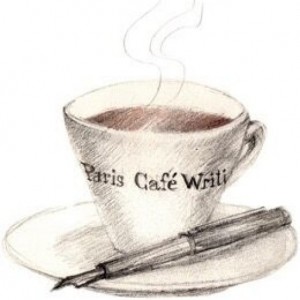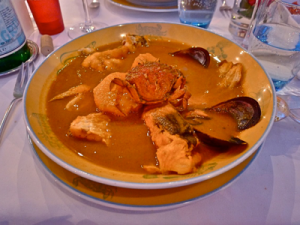Off to Marseilles for Bouillabaisse
By Patricia Tennison
www.ParisCafeWriting.com
Bouillabaisse and I have a history.
For years, I made this fish soup—from scratch, fish heads and all—for Christmas Eve dinner. Then, to prepare myself when I first became a restaurant reviewer for the Chicago Tribune, I invited friends over and served them bouillabaisse made four ways so that I could store the taste memory of chefs who (1) cheat (canned clam broth), (2) cater to fish haters (chicken broth!), (3) cheap out (no saffron), or (4) really serve a classic dish.
For my second cookbook, Glorious Fish in the Microwave, I converted the recipe so that it could be made…in the microwave. Amazing, when I think about that now. There was a handful of us writers (Barbara Kafka and I came in 1st and 2nd a couple times at the James Beard Awards) who proved you could make such creative dishes with a microwave oven. But, (don’t quote me) why would you? We have all moved on.
However, there was one essential ingredient missing from my history with bouillabaisse: I had never been to Marseilles. I had never sat in a harbor-side restaurant and the same day inhaled the sea and the rich seafood broth, made with fish caught in the Mediterranean and served in the city where it all began.
This summer, Joe and I left Paris to fly to Marseilles to take care of that detail. We stayed two nights. And ate fish soup three times.
Is a Marseilles bouillabaisse different from what we can make in Chicago—or what we had later in a restaurant back in Paris? Of course. Terroir is part of the mystique, part of the reason for travel.
The old harbor, and an odd translation
We picked the reasonably priced (92 euros/$118), Hermes Hotel, 2 rue Bonneterie, where Joe snapped the above harbor photo from the roof terrace.
I love this view. However, I have to laugh when I spot the Notre Dame de la Garde basilica, in the center of the photo, high on a hill, topped with a statue of the Madonna and Child. The huge, copper and gold leaf statue is the symbol of Marseilles, the repeated image in the tourist shops, and the reason we later took a trolley tour.
As we rounded a curve heading toward the basilica and our first good view of the Madonna and Child, the recording on the trolley announced in English:
“…the virgin and the kid.”
Translation is a tricky field….
Restaurant Michel
For our first stop, however, we dropped off our luggage and walked from our hotel in the Vieux Port past the thick walls of the old Fort St. Nicolas. The fort was built by the fearful Louis XIV who ordered that the cannons face not the sea to deter foreign invaders but toward the city to thwart any revolutionary French. After a half hour walk, we arrived at a small public beach, La Plage des Catalans, crammed with families and volleyball players.
Restaurant Michel, 6 rue des Catalans, is just across the street, an air-conditioned, crisp-linens spot with enough large windows and mirrors to admit the scenes of the beach and passersby.
Let’s pause at this point to reflect on the goal: authentic, humble fish soup, concocted from the fishermen’s daily catch, served with stale bread and hearty garlic chips. Were we in the right place?
We were escorted by a waiter wearing a double-breasted jacket with epaulettes to a generous table easily twice the size of any restaurant in Paris. At another table, a bottle of white cassis—the classic wine with bouillabaisse—leaned leisurely in a silver bucket. The menu noted that Restaurant Michel has been serving bouillabaisse since 1946 and that to experience it would cost us 63 euros/$81, each.
Why is bouillabaisse so expensive? Answer: fresh-caught fish are expensive. Modern bouillabaisse includes loup de mer (sea bass), rascasse (a bony, coastal fish), St. Pierre (John Dory), and other fresh catch. The fish are boiled (bouillier) not in simple water but in previously made fish broth that starts with fish bones and is enhanced with leeks, tomatoes, garlic, fragrant olive oil and herbs such as thyme, fennel, and saffron. The starring fish then are added one variety at a time, the denser ones first, so that the thinner ones don’t overcook.
The humble soup has turned into an event. First, the waiter presents a platter of whole, raw fish that will go into our soup. While the soup cooks in the kitchen, we share an appetizer and soon the bouillabaisse side dishes appear: little bowls of croutons; peeled, fresh garlic; and rouille, a rust (rouille)-colored, thick and spicy spread of olive oil, garlic, and red pepper.
Next, the fish come back, cooked, and the waiter bones them in front of us. He artfully arranges the boned fish, plus cooked, white potato slices, on a plate. Then, with a silver ladle and from a silver chafing dish, carefully pours the rust-colored, highly aromatic broth into our soup bowls.
Now the work is up to us. Rub a piece of fresh garlic on a crouton, top the crouton with a dab of rouille, and plop it into the broth to soften. Add some fish and potatoes to the bowl. Drop a little more rouille atop a morsel of fish, if you like. The rules are flexible.
* Reasons to go to Restaurant Michel:
The location is a little less touristy. The fin fish–only bouillabaisse (no shellfish) seems a bit more authentic.
Restaurant Miramar
This was our only must-do restaurant and a sentimental favorite because Joe had already dined there a few years earlier with our daughter, Ashley, and niece Tessa.
I even wore heels. (“Slow down, Joe. It’s hard to walk in these things.”)
The Restaurant Miramar, 12 Quai du Port, sprawls onto the sidewalk in front of the old harbor. If you walked this tourist area twice to pick out the “best” splurge restaurant, this would be it.
The bouillabaisse was 59 euros/$76, each. However, we racked up a much higher bill because we opted for the truffle-rich appetizers, the classic white cassis wine, and later the “bouillabaisse surprise” dessert. (No, it’s not fish. I recommend it, but I won’t reveal it, because … it’s a surprise.)
Critics could easily snub the bouillabaisse here. The broth was excellent, but the showy display (photo on the left) includes shellfish not historically part of the humble soup. I say, get over it. At home, I make a more festive version too, and especially like the flavor of fresh mussels. However, the colorful little red crab added here was impossible to eat with any grace.
The show—the presentation, the boning of the fish, the side dishes—was excellent.
* Reasons to go to Restaurant Miramar:
The creative menu. Fine mix of attentive, even friendly service. The quality of the cooked fish in the bouillabaisse: each fish maintained its individual flavor.
Restaurant Au Lamparo
On our last day, we only had time for lunch, so we returned to a small restaurant in Place de Lenche, behind city hall in the old, hilly Panier neighborhood. Restaurant au Lamparo has a pretty, sunny terrace where we had previously enjoyed fresh sardines, another Marseilles specialty.
A staple on the menu is soupe de poissons de roche—traditionally a soup from simpler, little fish in the area—for 12 euros/$15. I was curious to see how it compared.
The side dishes for the soup arrived in a rough basket (see above photo on the right): croutons; peeled, fresh garlic; a saffron-yellow (instead of the red rust-colored) rouille; and this time a small bowl of grated gruyere to sprinkle atop the croutons or in the soup, as we pleased.
The full-flavored broth, although it lacked some of the overtones of the bouillabaisse in the other restaurants, was still excellent. The color reflected the same saffron-yellow of the rouille.
Because my previous two main meals had been elaborate bouillabaisse, here I did not miss the extra plate of boned fish. If I did, I probably could have ordered a side of simple, grilled fish, plopped morsels into the soup, and still have come out way ahead financially.
*Reasons to go to Restaurant au Lamparo:
A beautifully flavored fish broth with all the fun of the side dishes, but at a humble price.
The photos: Three photos from Marseilles: From the left, the old harbor; the elaborate bouillabaisse at Restaurant Miramar; simpler soupe de poisson de roche at Au Lamparo.
To email or to unsubscribe: info@www.pariscafewriting.com
Copyright 2010 Paris Café Writing–All Rights Reserved


